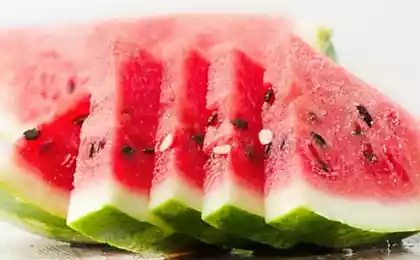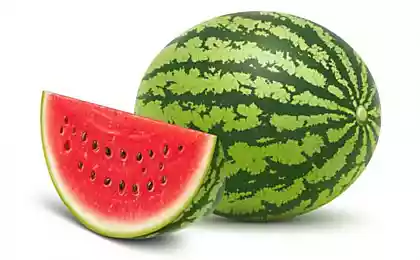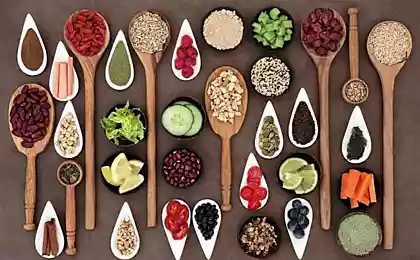489
Watermelon protects the skin from ultraviolet rays
The flesh of the watermelon not only quenches thirst in the summer heat, but also replenishes the body with antioxidant lycopene and vitamin A. Delicious and juicy watermelon is an excellent source of so necessary in hot weather, water and electrolytes. Botanists refer to watermelon family Cucurbitaceae and genus citrullus. Thus, it is a close relative of the musk melon (cantaloupe), pumpkin and also have numerous useful properties.
Watermelon vines spread along the soil surface. Watermelon has become particularly acute in a tropical climate. Its origin goes back to the South the African continent. Out the watermelon and spread to other tropical and subtropical areas. A few weeks after planting, the plant blooms with numerous yellow flowers for pollination which honey bees.

The English name of watermelon "watermelon" means "water melon". On resource Nutrition And You says a lot about the excellent properties and useful qualities of the watermelon. The watermelon has a thick peel is green or yellow. On its surface are often light green or grayish vertical stripes. Inside is his juicy pink, red or yellow flesh with numerous black seeds, which are closer to the center. The seeds are in the pulp, which occupies approximately one third of its volume.
Watermelon has a neutral flavor, resembling the flavor is light sugar syrup. It has a crisp flesh, in contrast to the cantaloupe, the flesh of which is characterized by a soft, creamy texture. Grown in different parts of the world the watermelons are different sizes, shapes and colors, including the colors of its pulp.
Benefits of watermelon for health
Watermelon is rich in electrolytes and water and is able to quench your thirst in the summer heat.
It is low in calories (just 30 calories per 100 grams) and low in fat. Watermelon in abundance contains numerous enhance health phytonutrients and antioxidants.
Watermelon — an excellent source which is a natural antioxidant of vitamin A. 100 grams of fresh pulp of watermelon contains 569 milligrams of this vitamin, accounting for 19% of the recommended daily value of consumption. This vitamin is among the most essential for vision and immunity. Vitamin a is also required for maintaining healthy skin and mucous membranes. Eating fruits rich in vitamin A is one of the ways to prevent lung cancer and oral cavity.
Watermelon is also rich in antioxidant flavonoids — lycopene, beta-carotene, lutein, zeaxanthin and cryptoxanthin. These antioxidants have been found to provide protection against cancer of the colon, prostate, breast, endometrial (uterine), lung, and pancreas. In watermelon fitohimikalii, lycopene and carotenoids have the ability to protect cells and other structures of the body from free oxygen radicals.
Watermelon is an excellent source of carotenoid pigment lycopene and in this respect, superior to raw red tomatoes. In 100 grams of watermelon pulp contains 4532 micrograms of lycopene, and tomatoes — only 2573 micrograms. Studies show that lycopene provides some protection to skin from harmful UV rays.
Watermelon is also a good source of potassium. Potassium is an important component fluids of the cells and organism, helps control heart rate and blood pressure. Thus, it helps prevent stroke and coronary heart disease.
In addition, it contains significant amounts of vitamin B6 (pyridoxine), thiamin (vitamin B1), vitamin C and manganese. The use of rich vitamin C foods helps the body develop resistance to infectious agents and allows him to be cleansed from harmful free radicals of oxygen. Manganese is used by the body as a factor-associated antioxidant enzyme (an enzyme called superoxide dismutase.
The total antioxidant level of watermelon-defined indicator ORAC is 142 µmol TE/100 grams.
Caution
Cases of allergies to watermelon are rare. Its seeds should be removed, but even in case of accidental ingestion they are not toxic. Watermelon is fairly high glycemic index (GI) — ~75.
Nutritional value of watermelon
In parentheses are the percentage of the daily allowance. Nutritional value is based on 100 grams of fresh watermelon according to information from the Ministry of agriculture of the USA, shown in the resource Nutrition And You.
General information:
energy value — 30 calories (1,5%);
carbohydrates and 7.6 grams (6%);
protein — 0.6 grams (1%);
fats — 0.15 grams (0.5 per cent);
fiber, part of the food — 0,4 gram (1%).
Vitamins:
folic acid (vitamin B9) is 3 micrograms (1%);
nicotinic acid (vitamin B3) — 0,178 milligrams (1%);
Pantothenic acid — 0,221 milligrams (4,5%);
pyridoxine (vitamin B6) — 0.045 milligrams (3,5%);
thiamine (vitamin B1) — 0,033 milligram (3%);
vitamin a, which very much is contained in dandelion — 569 international units (IU, IU) — 19%;
vitamin C — 8.1 mg (13,5%);
vitamin E — 0,05 mg (0,5%).
Electrolytes:
sodium — 1 milligram (~0%);
potassium 112 milligrams (2.5 percent).
Minerals:
calcium — 7 mg (0,7%);
copper — 42 micrograms (or 4.5%);
iron — 0.24 mg (3%);
magnesium — 10 mg (2,5%);
manganese — 0,038 mg (1,5%);
zinc — 0.10 mg (1%).
Phytonutrients:
alpha-carotene (α-carotene) — 303 micrograms;
beta-cryptoxanthin (β-cryptoxanthin) is 78 micrograms;
lutein-zeaxanthin — 8 micrograms;
lycopene — 4532 micrograms. published
P. S. And remember, only by changing their consumption — together we change the world! ©
Source: hi-news.ru
Watermelon vines spread along the soil surface. Watermelon has become particularly acute in a tropical climate. Its origin goes back to the South the African continent. Out the watermelon and spread to other tropical and subtropical areas. A few weeks after planting, the plant blooms with numerous yellow flowers for pollination which honey bees.

The English name of watermelon "watermelon" means "water melon". On resource Nutrition And You says a lot about the excellent properties and useful qualities of the watermelon. The watermelon has a thick peel is green or yellow. On its surface are often light green or grayish vertical stripes. Inside is his juicy pink, red or yellow flesh with numerous black seeds, which are closer to the center. The seeds are in the pulp, which occupies approximately one third of its volume.
Watermelon has a neutral flavor, resembling the flavor is light sugar syrup. It has a crisp flesh, in contrast to the cantaloupe, the flesh of which is characterized by a soft, creamy texture. Grown in different parts of the world the watermelons are different sizes, shapes and colors, including the colors of its pulp.
Benefits of watermelon for health
Watermelon is rich in electrolytes and water and is able to quench your thirst in the summer heat.
It is low in calories (just 30 calories per 100 grams) and low in fat. Watermelon in abundance contains numerous enhance health phytonutrients and antioxidants.
Watermelon — an excellent source which is a natural antioxidant of vitamin A. 100 grams of fresh pulp of watermelon contains 569 milligrams of this vitamin, accounting for 19% of the recommended daily value of consumption. This vitamin is among the most essential for vision and immunity. Vitamin a is also required for maintaining healthy skin and mucous membranes. Eating fruits rich in vitamin A is one of the ways to prevent lung cancer and oral cavity.
Watermelon is also rich in antioxidant flavonoids — lycopene, beta-carotene, lutein, zeaxanthin and cryptoxanthin. These antioxidants have been found to provide protection against cancer of the colon, prostate, breast, endometrial (uterine), lung, and pancreas. In watermelon fitohimikalii, lycopene and carotenoids have the ability to protect cells and other structures of the body from free oxygen radicals.
Watermelon is an excellent source of carotenoid pigment lycopene and in this respect, superior to raw red tomatoes. In 100 grams of watermelon pulp contains 4532 micrograms of lycopene, and tomatoes — only 2573 micrograms. Studies show that lycopene provides some protection to skin from harmful UV rays.
Watermelon is also a good source of potassium. Potassium is an important component fluids of the cells and organism, helps control heart rate and blood pressure. Thus, it helps prevent stroke and coronary heart disease.
In addition, it contains significant amounts of vitamin B6 (pyridoxine), thiamin (vitamin B1), vitamin C and manganese. The use of rich vitamin C foods helps the body develop resistance to infectious agents and allows him to be cleansed from harmful free radicals of oxygen. Manganese is used by the body as a factor-associated antioxidant enzyme (an enzyme called superoxide dismutase.
The total antioxidant level of watermelon-defined indicator ORAC is 142 µmol TE/100 grams.
Caution
Cases of allergies to watermelon are rare. Its seeds should be removed, but even in case of accidental ingestion they are not toxic. Watermelon is fairly high glycemic index (GI) — ~75.
Nutritional value of watermelon
In parentheses are the percentage of the daily allowance. Nutritional value is based on 100 grams of fresh watermelon according to information from the Ministry of agriculture of the USA, shown in the resource Nutrition And You.
General information:
energy value — 30 calories (1,5%);
carbohydrates and 7.6 grams (6%);
protein — 0.6 grams (1%);
fats — 0.15 grams (0.5 per cent);
fiber, part of the food — 0,4 gram (1%).
Vitamins:
folic acid (vitamin B9) is 3 micrograms (1%);
nicotinic acid (vitamin B3) — 0,178 milligrams (1%);
Pantothenic acid — 0,221 milligrams (4,5%);
pyridoxine (vitamin B6) — 0.045 milligrams (3,5%);
thiamine (vitamin B1) — 0,033 milligram (3%);
vitamin a, which very much is contained in dandelion — 569 international units (IU, IU) — 19%;
vitamin C — 8.1 mg (13,5%);
vitamin E — 0,05 mg (0,5%).
Electrolytes:
sodium — 1 milligram (~0%);
potassium 112 milligrams (2.5 percent).
Minerals:
calcium — 7 mg (0,7%);
copper — 42 micrograms (or 4.5%);
iron — 0.24 mg (3%);
magnesium — 10 mg (2,5%);
manganese — 0,038 mg (1,5%);
zinc — 0.10 mg (1%).
Phytonutrients:
alpha-carotene (α-carotene) — 303 micrograms;
beta-cryptoxanthin (β-cryptoxanthin) is 78 micrograms;
lutein-zeaxanthin — 8 micrograms;
lycopene — 4532 micrograms. published
P. S. And remember, only by changing their consumption — together we change the world! ©
Source: hi-news.ru
A priceless lesson for the unfaithful husband
Richard Davidson: well-being is a skill that can be trained






















